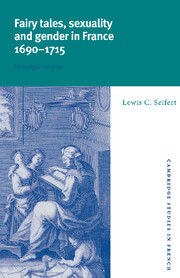Book contents
- Front Matter
- Contents
- Acknowledgments
- Note on translations and quotations
- Introduction
- Part I MARVELOUS STORYTELLING
- Part II MARVELOUS DESIRES
- Chapter 4 Quests for love: visions of sexuality
- Chapter 5 (De)mystifications of masculinity: fictions of transcendence
- Chapter 6 Imagining femininity: binarity and beyond
- Afterword
- Notes
- Selected bibliography
- Index
- Cambridge Studies in French
Chapter 6 - Imagining femininity: binarity and beyond
Published online by Cambridge University Press: 22 September 2009
- Front Matter
- Contents
- Acknowledgments
- Note on translations and quotations
- Introduction
- Part I MARVELOUS STORYTELLING
- Part II MARVELOUS DESIRES
- Chapter 4 Quests for love: visions of sexuality
- Chapter 5 (De)mystifications of masculinity: fictions of transcendence
- Chapter 6 Imagining femininity: binarity and beyond
- Afterword
- Notes
- Selected bibliography
- Index
- Cambridge Studies in French
Summary
It is hardly an exaggeration to say that fairy tales are obsessed with femininity. In an overwhelming proportion of the stories that Western cultures have enshrined as classics, women are central characters. These narratives are concerned above all else with defining what makes women different from men and, more precisely, what is and is not acceptable feminine behavior. Beauty (of “Beauty and the Beast” fame), Cinderella, Little Red Riding Hood, and Sleeping Beauty are simply the most notorious of the fairy-tale heroines who haunt our collective imaginations and, as many scholars have argued, influence our expectations of femininity. More often than not, in their mass-produced varieties these archetypal women have been imbued with highly conservative prescriptions. Beauty exemplifies daughterly love for fathers; Cinderella and Sleeping Beauty demonstrate the “rewards” of submission to the male-lover-turned-husband; and Little Red Riding Hood leaves a warning about the dangers of girls' disobedience or foolishness. The fairy-tale genre has become a powerful tool for making listeners and readers aware of both the ramifications and the conditions of “proper” feminine conduct.
The classic fairy tales mentioned above, among many others, entertain questions that have long haunted patriarchal Western consciousness: “What is Woman?” and Freud's infamous related question, “What does Woman want?” These questions bespeak an extreme uneasiness on the part of both the male subjects who have uttered them and the patriarchal cultures that have conceived them.
- Type
- Chapter
- Information
- Fairy Tales, Sexuality, and Gender in France, 1690–1715Nostalgic Utopias, pp. 175 - 219Publisher: Cambridge University PressPrint publication year: 1996

